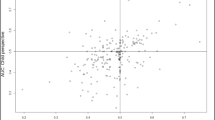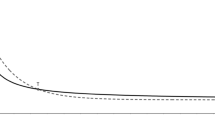Abstract
This study examined whether time trade-off (TTO) values adjusted for time preferences are more consistent with individuals’ preferences. This was carried out by testing the constant proportional trade-off (CPTO) assumption, and both individual specific and standard discount rates were used. The results show that the mean adjustment factor is around 0.03. This may influence relative cost-effectiveness in economic evaluations. The CPTO assumption holds with respect to both unadjusted TTO values and TTO values adjusted for individuals’ time preference, and therefore no conclusions can be drawn as to whether the adjusted values are more consistent with individuals’ preferences. However, the CPTO assumption is violated when standard discount rates are used. This clearly shows that the use of standard discount rates should be avoided. Further exploration of the time preference bias and other biases in TTO is identified as an important area of future research.
Similar content being viewed by others
References
Nord E (1992) Methods for quality adjustment of life years. Soc Sci Med 34:559–569
Bleichrodt H (2002) A new explanation for the difference between time trade-off utilities and standard gamble utilities. Health Econ 11:447–456
Dolan P, Jones-Lee M (1997) The time trade-off: a note on the effect of lifetime reallocation of consumption and discounting. J Health Econ 16:731–739
Loomes G, McKenzie L (1989) The use of QALYs in health care decision making. Soc Sci Med 28:299–308
MacKeigan LD, Gafni A, O’Brien BJ (2003) Double discounting of QALYs. Health Econ 12:165–169
Cairns JA, van der Pol MM (2000) The estimation of marginal time preference in a UK-wide sample (TEMPUS) project. Health Technol Assess 4 (1)
Krahn M, Gafni A (1993) Discounting in the economic evaluation of health care interventions. Med Care 31:403–418
Gyrd-Hansen D (2002) Comparing the results of applying different methods of eliciting time preferences for health. Eur J Health Econ 3:10–16
Olsen JA (1994) Persons vs years: two ways of eliciting implicit weights. Health Econ 3:39–46
Stavem K, Kristiansen IS, Olsen JA (2002) Association of time preference for health with age and disease severity. Eur J Health Econ 3:120–124
Martin AJ, Glasziou PP, Simes RJ, Lumley T (2000) A comparison of standard gamble, time trade-off, and adjusted time trade-off scores. Int J Technol Assess Health Care 16:137–147
Stiggelbout A, Kiebert GM, Kievit J, Leer JWH, Stoter G, Haes de JCJM (1994) Utility assessment in cancer patients: adjustment of time tradeoff scores for the utility of life years and comparison with standard gamble scores. Med Decis Making 14:82–90
Dolan P, Gudex C (1995) Time preference, duration and health state valuations. Health Econ 4:289–299
Sox HC, Blatt MA, Higgins MC, Marton KI (1986) Medical decision making. Butterworths: Boston
Johannesson M, Pliskin JS, Weinstein MC (1994) A note on QALYs, time tradeoff, and discounting. Med Decis Making 14:188–193
Gafni A, Torrance GW (1984) Risk attitude and time preference in health. Manag Sci 30:440–451
Chapman GB, Nelson R, Hier DB (1999) Familiarity and time preferences: decision making about treatments for migraine headaches and Crohn’s disease. J Exp Psychol Appl 5:17–34
Ganiats TG, Carson RT, Hamm RM, Cantor SB, Sumner W, Spann SJ, Hagen MD, Miller C (2000) Population-based time preferences for future health outcomes. Med Decis Making 20:263–270
Redelmeier DA, Heller DN (1993) Time preference in medical decision making and cost-effectiveness analysis. Med Decis Making 13:212–217
Pol van der MM, Cairns JA (2000) Negative and zero time preference for health. Health Econ 9:171–175
Loewenstein G, Elster J (1992) Choice over time. Russell Sage Foundation: New York
Pliskin JS, Shepard DS, Weinstein MC (1980) Utility functions for life years and health status. Oper Res 28:206–224
Sackett DL, Torrance GW (1978) The utility of different health states as perceived by the general public. J Chronic Dis 31:697–704
McNeil BJ, Weichselbaum R, Pauker SG (1981) Speech and survival: trade-offs between quality and quantity of life in laryngeal cancer. N Engl J Med 305:982–987
Kirsch J, McGuire A (2000) Establishing health state valuations for disease specific states: an example from heart disease. Health Econ 9:149–158
Bleichrodt H, Johannesson M (1997) The validity of QALYs: an experimental test of constant proportional trade-off and utility dependence. Med Decis Making 17:21–32
Roux L (2002) Impact assessment and strategy evaluation in obesity: a decision analytic and economic evaluative perspective. Thesis, University of Calgary
Pol van der MM, Cairns JA (2003) Methods for eliciting time preferences over future health events. In: Scott A, Maynard A, Elliott R (eds) Advances in health economics. Wiley: Chichester
Harvey C (1986) Value functions for infinite-period planning. Manag Sci 32:1123–1139
Bland M (1995) An introduction to medical statistics. Oxford University Press: New York
O’Brien BJ, Drummond MF (1994) Statistical versus quantitative significance in the socioeconomic evaluation of medicines. Pharamcoeconomics 5:389–398
Loewenstein G, Prelec D (1991) Negative time preference. AEA Papers Proc 81:347–352
Dolan P (2000) The measurement of health-related quality of life for use in resource allocation decisions in health care. In: Culyer AJ, Newhouse JP (eds) Handbook of health economics. Elsevier Science: Amsterdam
Wit GA de, Busschbach JJV, De Charro FTH (2000) Sensitivity and perspective in the valuation of health status: whose values count? Health Econ 9:109–126
Lazaro A, Barberan R, Rubio E (2002) The economic evaluation of health programmes: why discount health consequences more than monetary consequences. Appl Econ 34:339–350
Acknowledgements
We thank Paul Dolan, John Cairns, and Cam Donaldson for comments on a previous version of this contribution. This work was supported by Alberta Heritage Foundation for Medical Research and the Canadian Institute for Health Research. M.v.d.P. was funded through the Svare Chair at the time of this study. The views expressed in this contribution are those of the authors, and not those of the funders.
Author information
Authors and Affiliations
Corresponding author
Rights and permissions
About this article
Cite this article
van der Pol, M., Roux, L. Time preference bias in time trade-off. Eur J Health Econ 6, 107–111 (2005). https://doi.org/10.1007/s10198-004-0265-y
Received:
Accepted:
Issue Date:
DOI: https://doi.org/10.1007/s10198-004-0265-y




